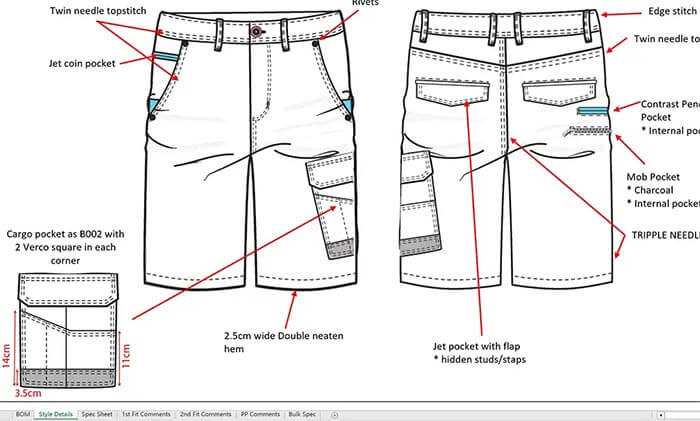The product specification sheet is one of the important documents in the production process. Today’s post shows the basic information about the product specification. Let’s take a look.
What is a product specification sheet?
A product specification sheet is a document that details the requirements and characteristics of the product, which can make your suppliers better understand products, thus making the process of product sourcing easier.
The following is a garment specification sheet.
Image: castelhanos.net
What is the purpose of product specifications?
Get more accurate quotations
Here I take sweatshirt customization as an example.
If you clearly put all your product requirements in the product specification (350gsm cotton fabric, sweatshirt size based on the size chart you gave, designed pattern embroidered on the sweatshirt, 1000 pieces, etc.), then the supplier can understand more clearly about the product you want, and give you an accurate quotation according to your requirements.
Because the materials of fabrics, size, printing methods, quantity, and other factors will affect the price of the product.
Help suppliers produce efficiently
A detailed product specification sheet provides your supplier with a reference standard in product sample development. Suppose you have specific requirements for the pant style. Then, you can attach a specific sheet to describe the desired style as below. This way, your supplier can quickly know what you want.
Image source: LanCai Garment
It’s important to provide as detailed and clear product specifications as possible, especially for complex projects like digital electronics. If you only give a sketch of the product, the supplier will have to confirm with you many parameters of the product. It is time-consuming.
In addition, your supplier may use cheaper materials to reduce costs without a product specification sheet, thus the product quality may not meet your requirements.
Act as an inspection checklist
Once the PP sample has finished, you can use the product spec sheet as a checklist to assess whether it is consistent with your requirements. If there are some quality problems or some other factors that don’t meet your demand, you can request to return it for a redo or repair.
Product spec sheet template and key info
Template of a product spec sheet
There is no strict format for a product specification, as long as it clearly details your product requirements. Below is a template of the garment specification sheet for your reference.
Key info in a product spec sheet with a real example
Here I take a garment specification named “casual sports suits” as an example, and list four main points of the product specification sheet.
Product basic information
It consists of the specific requirements of the product, such as name, code, usage, materials, dimension, weight, design, quality, etc. Here you’d better describe your product in as much detail as possible.
For example, a casual sports suit consists of a t-shirt and sweatpants.
- Materials: 300gsm, 60% cotton + 40% polyester with velvet inside
- Dimension: The size range of T-shirts is S-XL, and the size range of sweatpants is S-L. You can attach a size chart if any.
- Color and quantity: If you custom 1000 red wine suits, please use Pantone color 186C, instead of just saying “red”, to ensure the supplier can find the right color.
- Design: Screen printing is used to print the design on the front and back of the T-shirt, and the logo on the sweatpants is used by embroidery. It is important to attach pictures and links for reference to make the product more intuitive.
Product labeling and packing
You should describe the requirements and specifications of labeling and packaging. Labels should include the design of the main label and information about the care label. The packaging can be described as follows: casual sports suits should be packaged in a Zipper bag.
Testing & certifications
This refers to what standards the product should follow, and what tests and certifications it should pass. For example, you want your casual sports suit to be USA-compliant and meet the ASTM standard. You should do color fastness and composition testing to check whether the fabric of the garment meets your requirements if necessary.
After understanding the above key information, you can start writing your product specification sheet. Once you have written it, you can send it to your potential supplier, like JingSourcing. If you are not sure about the requirements, we will communicate with you to confirm.
If you are new to product development, or you do not have a lot of experience in this area, for example, you may only have a sketch, a general idea, like some of our customers. Our sourcing agents will guide you, and ask for detailed information about the product to help you to be more specific about the product. We will then help you make a product specification sheet for sampling and subsequent production.
JingSourcing Can Make Your Idea Come True
- Various products sourcing
- At a competitive price
- Production follow-up



